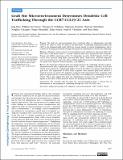| dc.contributor.author | Hua, Jing | en_US |
| dc.contributor.author | Stevenson, William | en_US |
| dc.contributor.author | Dohlman, Thomas H. | en_US |
| dc.contributor.author | Inomata, Takenori | en_US |
| dc.contributor.author | Tahvildari, Maryam | en_US |
| dc.contributor.author | Calcagno, Narghes | en_US |
| dc.contributor.author | Pirmadjid, Negar | en_US |
| dc.contributor.author | Sadrai, Zahra | en_US |
| dc.contributor.author | Chauhan, Sunil K. | en_US |
| dc.contributor.author | Dana, Reza | en_US |
| dc.date.accessioned | 2016-11-18T20:06:11Z | |
| dc.date.issued | 2016 | en_US |
| dc.identifier.citation | Hua, Jing, William Stevenson, Thomas H. Dohlman, Takenori Inomata, Maryam Tahvildari, Narghes Calcagno, Negar Pirmadjid, Zahra Sadrai, Sunil K. Chauhan, and Reza Dana. 2016. “Graft Site Microenvironment Determines Dendritic Cell Trafficking Through the CCR7-CCL19/21 Axis.” Investigative Ophthalmology & Visual Science 57 (3): 1457-1467. doi:10.1167/iovs.15-17551. http://dx.doi.org/10.1167/iovs.15-17551. | en |
| dc.identifier.issn | 0146-0404 | en |
| dc.identifier.uri | http://nrs.harvard.edu/urn-3:HUL.InstRepos:29407768 | |
| dc.description.abstract | Purpose The graft site microenvironment has a profound effect on alloimmunity and graft survival. We aimed to study the kinetics and phenotype of trafficking antigen-presenting cells (APC) to the draining lymph nodes (DLNs) in a mouse model of corneal transplantation, and to evaluate the homing mechanisms through which graft site inflammation controls APC trafficking. Methods: Allogeneic donor corneas were transplanted onto inflamed or quiescent graft beds. Host- (YAe+) and donor (CD45.1+ or eGFP+)-derived APCs were analyzed by flow cytometry. Protein and mRNA expression of the CC chemokine receptor (CCR)7 ligands CCL19 and CCL21 were assessed using ELISA and Real-Time qPCR, respectively. Transwell migration assay was performed to assess the effect of DLNs isolated from hosts with inflamed graft beds on mature bone marrow–derived dendritic cells (BMDCs). Results: We found that inflamed graft sites greatly promote the trafficking of both recipient- and graft-derived APCs, in particular mature CCR7+ CD11c+ dendritic cells (DC). CCL19 and CCL21 were expressed at significantly higher levels in the DLNs of recipients with inflamed graft beds. The supernatant of DLNs from recipients with inflamed graft beds induced a marked increase in mature DC migration compared with supernatant from recipients with quiescent graft beds in a transwell assay. This effect was abolished by neutralizing CCL19 or CCL21. These data suggest that graft site inflammation increases the expression of CCR7 ligands in the DLNs, which promote mature DC homing and allorejection. Conclusions: We conclude that the graft site microenvironment plays a critical role in alloimmunity by determining DC trafficking through the CCR7-CCL19/21 axis. | en |
| dc.language.iso | en_US | en |
| dc.publisher | The Association for Research in Vision and Ophthalmology | en |
| dc.relation.isversionof | doi:10.1167/iovs.15-17551 | en |
| dc.relation.hasversion | http://www.ncbi.nlm.nih.gov/pmc/articles/PMC4819620/pdf/ | en |
| dash.license | LAA | en_US |
| dc.subject | antigen presenting cells | en |
| dc.subject | migration | en |
| dc.subject | microenvironment | en |
| dc.subject | CCR7 | en |
| dc.subject | CCL19 | en |
| dc.subject | CCL21 | en |
| dc.title | Graft Site Microenvironment Determines Dendritic Cell Trafficking Through the CCR7-CCL19/21 Axis | en |
| dc.type | Journal Article | en_US |
| dc.description.version | Version of Record | en |
| dc.relation.journal | Investigative Ophthalmology & Visual Science | en |
| dash.depositing.author | Stevenson, William | en_US |
| dc.date.available | 2016-11-18T20:06:11Z | |
| dc.identifier.doi | 10.1167/iovs.15-17551 | * |
| dash.contributor.affiliated | Calcagno, Narghes | |
| dash.contributor.affiliated | Stevenson, William | |
| dash.contributor.affiliated | Chauhan, Sunil | |
| dash.contributor.affiliated | Dana, Reza | |


